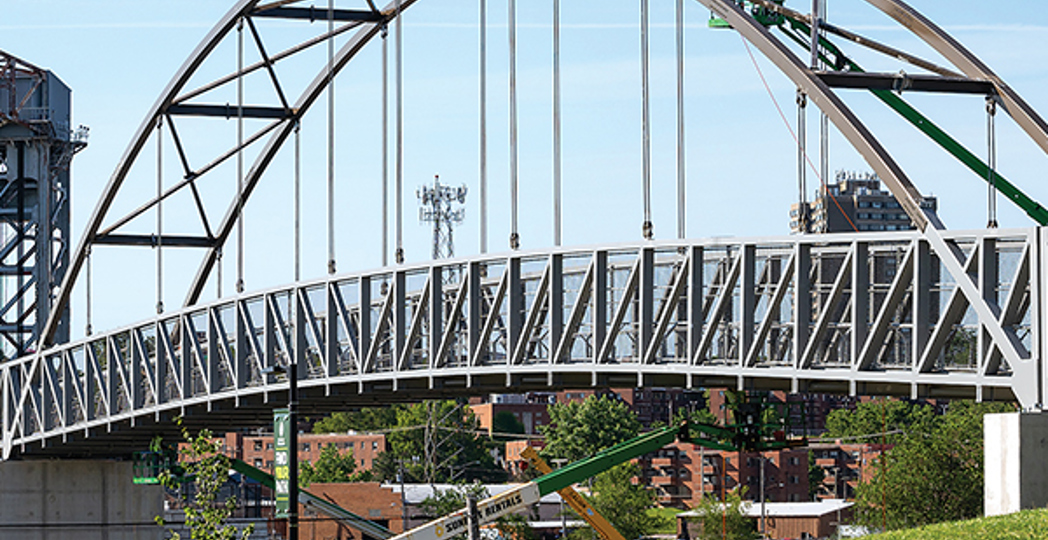The Towpath Trail: 100 Miles of Importance
by Chris Ronayne | Aug. 1, 2021 | 4:00 AM

With the cutting of a ribbon, the 100-mile Towpath Trail through the Ohio & Erie Canal National Heritage Area celebrates America’s industrial heartland and connects walkers, cyclists, joggers and naturalists on a continuous path from Cleveland to New Philadelphia through Cuyahoga, Summit, Stark and Tuscarawas counties.
Offering historical points of interest throughout the corridor and running through the Cuyahoga Valley National Park, the Towpath Trail is one of the great outdoor features of the region. For three decades, the nonprofit cultural heritage organization Canalway Partners has advocated for the $54 million in funds necessary to build the Cleveland section of the trail through the 5-mile complex maze of Cleveland’s industrial heritage. Mission accomplished.
Why is the Towpath Trail so important? The Towpath follows the historic mule path used to tow canal boats on a canal first envisioned by Washington and Jefferson as early as 1789 to connect Lake Erie to the Ohio River through a manmade inland transportation waterway. When the Ohio and Erie canal was ultimately built in the early 19th century, it linked New York to New Orleans, and Cleveland became the fulcrum of industrial America.
Along the trail, a story unfolds that was important enough to land a National Heritage Area designation in 1996. Chapters of the story include Camp Cleveland, where 15,000 Union soldiers trained for battle in what was known as University Heights — now today’s Tremont neighborhood of Cleveland. They include the advent of American rolled steel in the industrial valley of the Flats and the northern Lock, where laker ships transferred goods to canal boats guided by workers like a young James A. Garfield.
In addition to the rich history that the Towpath Trail reveals, it serves an economic purpose. Economic impact studies indicate that the Ohio & Erie Canalway National Heritage Area generates more than $400 million in economic impact and supports more than 4,200 jobs.
The Towpath Trail creates an amenity on the Cuyahoga River that will connect our communities to history and a recreational outlet like no other. It’s a significant visitor attraction in a National Heritage Area that runs through a scenic byway and a national park. Added up, the Towpath Trail stands to spark cultural tourism in Northeast Ohio, with 3 million people already visiting the Cuyahoga Valley National Park each year.
As the central spine of a sophisticated trail network, it will help develop Cleveland’s brand as a signature U.S. trail city, with a particular emphasis on the industry that built this country. The network gets better each month as the Cleveland Metroparks continues to complete projects like the Wendy Park Bridge, creating a lakefront link to the Towpath via the Cleveland Foundation Centennial Trail, and the Edgewater-Whiskey Island Connector, linking the West Side to the Flats. The CHEERS study is doing the same from Downtown Cleveland to Cleveland’s East Side neighborhoods along Lake Erie.
One goal remains beyond the Towpath Trail itself for Canalway Partners: completing Cleveland’s Central Park in the Flats — Canal Basin Park. For so many reasons, Canal Basin Park is a final clarion call:
- It will be a tremendous neighborhood and regional asset in the heart of one Northeast Ohio’s visitor hubs.
- It tells our story of industrial advance.
- It’s a trailhead to begin or end a journey on the 100-mile Towpath Trail.
- It’s a place where industrial America began.
As we prepare for the future, the time is now to enjoy what we have access to today. Eventually, you might find yourself traveling the entire 100 miles from Cleveland to Zoar. Along the way, take in the incredible history of our region, marvel at our past and imagine the future.
Trending
-
1
-
2
-
3
-
4
-
5










